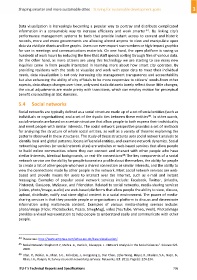Page 719 - Shaping smarter and more sustainable cities - Striving for sustainable development goals
P. 719
Data visualization is increasingly becoming a popular way to portray and distribute complicated
44
information in a consumable way to increase efficiency and work smarter . By linking city's
performance management systems to tools that provide instant access to current and historic
records, more and more governments are allowing almost anyone to view and manipulate open
data via vivid pie charts and line graphs. Users can even export raw numbers or high‐impact graphics
for use in meetings and communications materials. On one hand, the open platform is saving us
hundreds of work hours by reducing the time that staff spends sorting through files of various data.
On the other hand, as more citizens are using this technology we are starting to see many new
inquiries come in from people interested in learning more about how smart city operates. By
providing residents with the tools to visualize and work with open data to meet their individual
needs, data visualization is not only increasing city management transparency and accountability
but also enhancing the ability of city officials to be more responsive to citizens' needs.From other
aspects, data always changes over time, only used static datasets barely reflect those little changes,
the visual adjustments are made pretty with transitions, which can employ motion for perceptual
benefit crosscutting all SSC domains.
5.4 Social networks
Social networks are typically defined as a social structure made up of a set of social entities (such as
45
individuals or organizations) and a set of the dyadic ties between these entities . In other words,
social networks are based on a certain structure that allow people to both express their individuality
and meet people with similar interests. The social network perspective provides a set of methods
for analyzing the structure of whole social entities, as well as a variety of theories explaining the
patterns observed in these structures. The study of these structures uses social network analysis to
identify local and global patterns, locate influential entities, and examine network dynamics. Social
networking services (or social network sites) are websites or web‐based services that allow people
to build online communities where they can connect and interact with other people who have
46
similar interests, identical backgrounds, or real‐life connections .The key components of a social
network service are the ability for people to create a profile about themselves, the ability for people
to create a list of other people who have a shared connection or similar interests, and the ability to
view the connections made by other people in the network. Most social network services are web‐
based and provide means for users to interact over the Internet, such as e‐mail and instant
messaging. Examples of popular social network services include: Facebook, Twitter, LinkedIn,
Pinterest, GovLoop, MySpace, and Friendster. Related to social networks, media‐sharing services
(video, photo/image, audio) are web‐based platforms that allow people the ability to view, discuss,
upload, distribute, notify and store digital content in a social environment. The power of media‐
sharing services is that they provide people or organizations a platform to discuss and disseminate
information using multimedia content. Examples of various media‐sharing services include:
photo/image (Flickr, Photobucket, Picasa, SmugMug), video (YouTube, Vimeo, Veoh). Photo/image
provides a visual representation to help people to understand easily and communicate with other
people.
____________________
44 Please see: http://www.emprata.com/what‐we‐do/data‐visualization/.
45 Social Network: Stephen B.P, Mehra. A , Daniel J, Giuseppe. L . Network Analysis in the Social Sciences". Science 323.
2009.
46 Irfan, R., Bickler, G., Khan, S.U., Kolodziej, J., Hongxiang Li, Dan Chen, Lizhe Wang, Hayat, K., Madani, S.A., Nazir, B.,
Khan, I.A., Ranjan, R; Survey on social networking services. Networks, IET. 2013, Page(s): 224‐234.
ITU‐T's Technical Reports and Specifications 709

